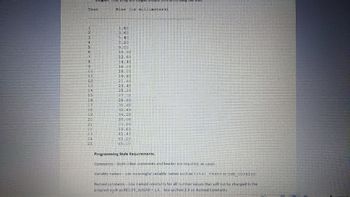
Database System Concepts
7th Edition
ISBN: 9780078022159
Author: Abraham Silberschatz Professor, Henry F. Korth, S. Sudarshan
Publisher: McGraw-Hill Education
expand_more
expand_more
format_list_bulleted
Concept explainers
Question
Can you help me with my python code for this.

Transcribed Image Text:Problem 1. Budgeted vs. Actual Expenses
Write program that asks the user to enter the amount that he or she has budgeted for a month.
Using a while loop, the user should be prompted to enter each of his or her expenses for the
month and keep a running total. When the loop finishes, the program should display the amount
that the user is over or under budget.
Design. Use an IPO diagram to design your program. See IPO diagram attached to this assignment.
Code. Write your program in Python using the above steps. Save your program as a py file with the
name yourlastname lab4.1.py
Output. Your program should produce correctly labeled output with dollar amounts rounded to 2
decimal places and dollar signs. Sample dialog:
Enter amount budgeted for the month: 500
Enter an amount spent (0 to quit): 50
Enter an amount
spent (0 to quit): 75
Enter an amount
spent (0 to quit): 800
Enter an amount
spent (0 to quit): 23.95
Enter an amount spent (C to quit): 0
Budgeted: $ 500.00
Spent: $948.95
You are $448.95 over budget. PLAN BETTER NEXT TIME!
Problem 2. Ocean Levels
Assuming the ocean's level is currently rising at about 1.8 millimeters per year, create an application
that displays the number of millimeters that the ocean will have risen each year for the next 25
years, You must use a loop to create the data output.
Focus
6-17 PM
Y
100%

Transcribed Image Text:Year
1
2
3
1
4
C
5
10
7
2
8
10
2322987222
12
16
17
18
20
24
Rise (in millimeters)
1.80
3.60
5.40
7.20
19.00
10.80
12.60
14.40
16.20
Found
18.00
19.80
21.60
23.40
25.20
27.00
28.80
30.60
32 40
34.20
36.00
37.80
39.60
41.40
43.20
45.00
Programming Style Requirements.
Comments - Both inline comments and header are required, as usual.
Variable names - use meaningful variable names such as total taxes or num cookies.
Named constants - Use named constants for all number values that will not be changed in the
program such as RECIPE SUGAR = 1.5. See section 2.9 on Named Constants
Ben Fra
EF
Expert Solution
This question has been solved!
Explore an expertly crafted, step-by-step solution for a thorough understanding of key concepts.
This is a popular solution
Trending nowThis is a popular solution!
Step by stepSolved in 3 steps with 1 images

Knowledge Booster
Learn more about
Need a deep-dive on the concept behind this application? Look no further. Learn more about this topic, computer-science and related others by exploring similar questions and additional content below.Similar questions
- Write a python code that does the following: - Asks student to enter his name - Ask them to enter their marks for 4 different modules. (Note: these marks should be out of 100 for each module) - Based on the average of the 4 different modules, the student should get the grade that they have achieved at that level. - The grades should follow the following trend - greater than or equal to 90 = A - from 80 to 89 inclusive = B - from 70 to 79 inclusive = C - from 60 to 69 inclusive = D - from 50 to 59 inclusive = E - below 50 = Farrow_forwarduse https://live.sympy.org/ (Links to an external site.) Review the examples about cardinality in Python using Sympy- https://www.geeksforgeeks.org/sympy-subset-cardinality-in-python/ (Links to an external site.) Explain each one, and what the result means Provide a link or a screenshot of working codearrow_forward
arrow_back_ios
arrow_forward_ios
Recommended textbooks for you
 Database System ConceptsComputer ScienceISBN:9780078022159Author:Abraham Silberschatz Professor, Henry F. Korth, S. SudarshanPublisher:McGraw-Hill Education
Database System ConceptsComputer ScienceISBN:9780078022159Author:Abraham Silberschatz Professor, Henry F. Korth, S. SudarshanPublisher:McGraw-Hill Education Starting Out with Python (4th Edition)Computer ScienceISBN:9780134444321Author:Tony GaddisPublisher:PEARSON
Starting Out with Python (4th Edition)Computer ScienceISBN:9780134444321Author:Tony GaddisPublisher:PEARSON Digital Fundamentals (11th Edition)Computer ScienceISBN:9780132737968Author:Thomas L. FloydPublisher:PEARSON
Digital Fundamentals (11th Edition)Computer ScienceISBN:9780132737968Author:Thomas L. FloydPublisher:PEARSON C How to Program (8th Edition)Computer ScienceISBN:9780133976892Author:Paul J. Deitel, Harvey DeitelPublisher:PEARSON
C How to Program (8th Edition)Computer ScienceISBN:9780133976892Author:Paul J. Deitel, Harvey DeitelPublisher:PEARSON Database Systems: Design, Implementation, & Manag...Computer ScienceISBN:9781337627900Author:Carlos Coronel, Steven MorrisPublisher:Cengage Learning
Database Systems: Design, Implementation, & Manag...Computer ScienceISBN:9781337627900Author:Carlos Coronel, Steven MorrisPublisher:Cengage Learning Programmable Logic ControllersComputer ScienceISBN:9780073373843Author:Frank D. PetruzellaPublisher:McGraw-Hill Education
Programmable Logic ControllersComputer ScienceISBN:9780073373843Author:Frank D. PetruzellaPublisher:McGraw-Hill Education

Database System Concepts
Computer Science
ISBN:9780078022159
Author:Abraham Silberschatz Professor, Henry F. Korth, S. Sudarshan
Publisher:McGraw-Hill Education

Starting Out with Python (4th Edition)
Computer Science
ISBN:9780134444321
Author:Tony Gaddis
Publisher:PEARSON

Digital Fundamentals (11th Edition)
Computer Science
ISBN:9780132737968
Author:Thomas L. Floyd
Publisher:PEARSON

C How to Program (8th Edition)
Computer Science
ISBN:9780133976892
Author:Paul J. Deitel, Harvey Deitel
Publisher:PEARSON

Database Systems: Design, Implementation, & Manag...
Computer Science
ISBN:9781337627900
Author:Carlos Coronel, Steven Morris
Publisher:Cengage Learning

Programmable Logic Controllers
Computer Science
ISBN:9780073373843
Author:Frank D. Petruzella
Publisher:McGraw-Hill Education